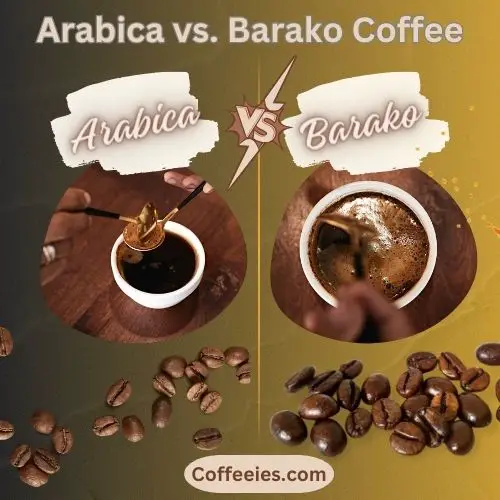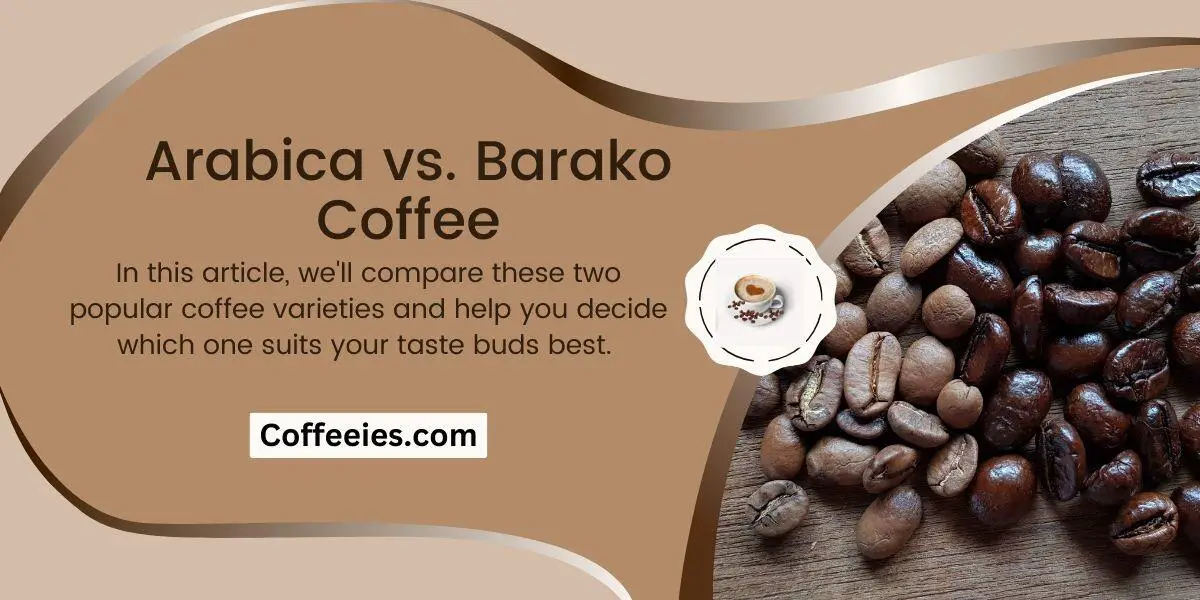Did you know that 60% of coffee consumed worldwide is made from Arabica beans? But have you ever tried Barako coffee?
In this article, we’ll compare these two popular coffee varieties and help you decide which one suits your taste buds best.
From their origins and growing conditions to flavor profiles and caffeine content, we’ll delve into every aspect. So, grab a cup of your favorite brew, and let’s explore the fascinating world of Arabica vs. Barako coffee.
Summary
- Arabica coffee originated in Ethiopia and spread across the Arabian Peninsula, Europe, and the Americas, while Barako coffee has its roots in the Batangas region of the Philippines.
- Arabica coffee is grown in higher altitudes and prefers cooler temperatures and specific soil conditions, while Barako coffee is grown in lower altitudes and is more tolerant of warmer temperatures and a wider range of soil types.
- Arabica coffee offers a smooth and mild taste with hints of sweetness, floral notes, and subtle acidity, while Barako coffee has a bold and strong flavor with a full-bodied taste, earthy undertones, and a distinct smoky aroma.
- Arabica coffee generally contains less caffeine compared to Barako coffee, with Arabica coffee containing approximately 80-130 mg of caffeine per 8 oz cup, and Barako coffee containing approximately 130-200 mg of caffeine per 8 oz cup.

14 Key Differences: Arabica vs. Barako Coffee

| Serial No. | Aspect | Arabica Coffee | Barako Coffee |
|---|---|---|---|
| 1 | Origin and History | Ethiopia, Arabian Peninsula, Europe, Americas | Batangas region, Philippines |
| 2 | Growing Conditions | Higher altitude, cooler climate, acidic soil | Lower altitude, tolerant to warmer temps |
| 3 | Flavor Profile | Delicate, nuanced, floral, subtle acidity | Bold, strong, full-bodied, earthy |
| 4 | Aroma and Fragrance | Floral, fragrant scent | Robust, earthy, woody, smoky |
| 5 | Caffeine Content | 80-130 mg per 8 oz cup | 130-200 mg per 8 oz cup |
| 6 | Roasting Process | Green beans to color transformation | Green to brown transformation |
| 7 | Brewing Methods | Pour-over, French press, espresso | “Kapeng barako” using phin |
| 8 | Price and Accessibility | Readily available, lower price | Limited availability, higher price |
| 9 | Health Benefits | Antioxidant-rich, cognition boost, metabolism | Similar benefits to Arabica |
| 10 | Popular Varieties/Blends | Single origin, espresso blend | Barako blend, dark roast |
| 11 | Sustainability/Fair Trade | High-altitude, fair trade cooperatives | Small-scale production, challenges in trade |
| 12 | Best Pairings/Food Comb. | Chocolate cake, butter croissant, etc. | Blueberry muffin, almond biscotti, etc. |
| 13 | Coffee Culture/Traditions | Various cultural traditions | Social rituals, solitary moments |
| 14 | Expert Opinions/Reviews | Insights on taste, market trends | Evaluations on taste, quality |
A Detailed Explanation of the Table
1. Origin and History:
You’ll be fascinated by the rich and intriguing history of Arabica and Barako coffee. Arabica coffee is believed to have originated in the highlands of Ethiopia, where it was first cultivated over a thousand years ago.
From there, it spread across the Arabian Peninsula and eventually made its way to Europe and the Americas. The name “Arabica” reflects its Arab origins.
On the other hand, Barako coffee has its roots in the Philippines. It is a robust variety that thrives in the volcanic soil of the Batangas region.
The word “Barako” means “strong” or “wild boar” in the local language, which perfectly captures the bold and intense flavor of this coffee.
Both Arabica and Barako coffee have rich histories and unique characteristics that contribute to their popularity among coffee lovers worldwide.
2. Growing Conditions:
To understand the differences between Arabica and Barako coffee, it’s important to consider their growing conditions.
Here are four key factors that contribute to the distinct characteristics of each coffee variety:
| Serial No. | Aspect | Arabica Coffee | Barako Coffee |
|---|---|---|---|
| 1 | Altitude | Thrives at 2,000 – 6,000 feet above sea level | Grown at 1,000 – 2,000 feet above sea level |
| 2 | Climate | Prefers cooler climate (60-70°F) | Tolerant of wider temperature range, warmer climates |
| 3 | Soil | Well-drained, acidic soil (pH 6-6.5) | Flourishes in various soil types, including loamy, clayey |
| 4 | Rainfall | Requires consistent rainfall (60-100 inches annually) | Withstands drier conditions, needs less rainfall |
Understanding the unique growing conditions of Arabica and Barako coffee sets the stage for exploring their diverse flavor profiles.
3. Flavor Profile:
To truly appreciate the differences between Arabica and Barako coffee, taste and compare their distinct flavor profiles. Arabica coffee is known for its delicate and nuanced flavors.
It offers a smooth and mild taste with hints of sweetness, floral notes, and a subtle acidity.
The flavor profile of Arabica coffee can vary depending on the region it is grown in, but it generally has a more complex and balanced taste compared to other coffee varieties.
On the other hand, Barako coffee has a bold and strong flavor. It is characterized by its full-bodied taste, earthy undertones, and a distinct smoky aroma.
Barako coffee is often described as having a robust and intense flavor that lingers on the palate. Tasting these two coffees side by side will allow you to appreciate the unique flavors they offer truly.
4. Aroma and Fragrance:
When tasting Arabica and Barako coffee side by side, you’ll notice the contrasting aroma and fragrance, with Arabica offering a more delicate and floral scent, while Barako emits a bold and smoky aroma.
Here are four key points to understand the differences in aroma and fragrance between Arabica and Barako coffee:

- Arabica: Known for its complex and nuanced aroma, Arabica coffee beans exude a fragrant scent reminiscent of flowers, fruits, and spices. It has a subtle sweetness that enhances the overall experience.
- Barako: On the other hand, Barako coffee possesses a robust and intense aroma that can be described as earthy and woody. It has a distinct smoky quality that adds depth to its fragrance.
- Sensory experience: Arabica’s delicate aroma creates a more refined and elegant sensory experience, while Barako’s bold aroma evokes a sense of strength and power.
- Personal preference: The choice between Arabica and Barako coffee ultimately comes down to personal preference. Some may prefer the gentle and floral notes of Arabica, while others may be drawn to the strong and smoky aroma of Barako.
With an understanding of the aroma and fragrance differences between Arabica and Barako coffee, it’s time to delve into their caffeine content.
5. Caffeine Content:
You’ll be surprised to learn that there is a significant difference in the caffeine content between Arabica and Barako coffee.
While both types of coffee beans have their unique flavor profiles, their caffeine content varies greatly. Arabica coffee generally contains less caffeine compared to Barako coffee.
Here’s a comparison of the caffeine content in Arabica and Barako coffee:
| Coffee Type | Caffeine Content (per 8 oz cup) |
|---|---|
| Arabica | 80-130 mg |
| Barako | 130-200 mg |
As you can see, Barako coffee packs a higher caffeine punch, making it a popular choice for those seeking an extra energy boost.
However, it’s important to note that caffeine content can vary depending on factors such as brewing method and bean roast level.
So, whether you prefer the milder Arabica or the bolder Barako, remember to enjoy your cup of coffee in moderation.
6. Roasting Process:
If you’re curious about how Arabica and Barako coffee beans are transformed into your favorite morning brew, let’s delve into the roasting process. Here’s a breakdown of what happens during this crucial step:
- Green beans: Both Arabica and Barako beans start as green, unroasted beans.
- Heat application: Roasting begins by applying heat to these green beans, which causes them to undergo chemical changes.
- Color transformation: As the beans heat up, they gradually change color from green to yellow, then to various shades of brown.
- Development of flavors: The longer the beans are roasted, the darker and more intense the flavors become.
Now that you understand the roasting process, it’s time to explore the next step: brewing methods.
7. Brewing Methods:
Try experimenting with different brewing methods to get the most out of your Arabica or Barako coffee beans. The brewing method you choose can greatly impact the taste and aroma of your coffee.
For Arabica beans, popular brewing methods include pour-over, French press, and espresso.
- Pour-over involves slowly pouring hot water over the coffee grounds, allowing for a more balanced and nuanced flavor.
- The French press brewing method extracts oils and flavors from the coffee beans, resulting in a rich and full-bodied cup of coffee.
- Espresso, on the other hand, is made by forcing pressurized hot water through finely-ground coffee, producing a concentrated and intense flavor.
For Barako beans, the traditional Filipino brewing method called “kapeng barako” involves using a phin, a drip coffee filter, to brew a strong and bold cup of coffee.
So, grab your favorite brewing equipment and start exploring the different brewing methods to find the one that suits your taste preferences the best.
8. Price and Accessibility:
You can easily find Arabica coffee beans in most supermarkets and specialty coffee shops, but Barako coffee may be more difficult to come by and often comes with a higher price tag.
Here are four factors that contribute to the price and accessibility differences between Arabica and Barako coffee:
- Growing Conditions: Arabica coffee requires specific high-altitude conditions, making it more accessible in regions like South America and Africa. Barako coffee, on the other hand, is native to the Philippines and is grown in limited quantities.
- Production Volume: Arabica coffee is the most widely produced coffee globally, resulting in higher availability and lower prices. Barako coffee is produced in smaller quantities, making it harder to find and more expensive.
- Demand and popularity: Arabica coffee is renowned for its delicate flavors and is highly sought after by coffee enthusiasts. As a result, it is in high demand and readily available. Barako coffee, with its bold and robust flavor, has a niche market and is not as widely known or popular.
- Import and export restrictions: Barako coffee is native to the Philippines, and there may be restrictions on its export. This can limit its availability in international markets, further contributing to its higher price.
Now that we have discussed the price and accessibility differences, let’s move on to the next section to explore the health benefits of Arabica and Barako coffee.
9. Health Benefits:
The health benefits of Arabica and Barako coffee are numerous and can contribute to your overall well-being.
Both types of coffee contain antioxidants that help protect your body against free radicals.
Additionally, coffee has been shown to improve cognitive function and enhance alertness, making it a great choice for those needing a mental boost.
It can also boost metabolism and aid in weight loss.
However, it’s important to note that moderation is key, as excessive coffee consumption can lead to negative effects such as increased heart rate and anxiety.
Consider the following table for a quick comparison of the health benefits of Arabica and Barako coffee:
| Health Benefits | Arabica Coffee | Barako Coffee |
|---|---|---|
| Antioxidant-rich | Yes | Yes |
| Improved cognition | Yes | Yes |
| Metabolism boost | Yes | Yes |
Choose the coffee that suits your taste preferences and enjoy its health benefits in moderation.
10. Popular Varieties and Blends:
Try out these four popular varieties and blends of Arabica and Barako coffee to find your perfect cup. Here are some options to consider:
- Arabica Single Origin: This variety offers a smooth and well-balanced flavor profile with hints of caramel and chocolate. It is known for its bright acidity and floral aroma.
- Barako Blend: A blend of Barako and Arabica coffee beans that combines the bold and intense flavor of Barako with the delicate and nuanced taste of Arabica. This blend offers a unique and rich experience.
- Arabica Espresso Blend: This blend is specifically crafted for espresso lovers, with a robust flavor. It has a thick crema and a rich, full-bodied taste that is perfect for your morning pick-me-up.
- Barako Dark Roast: For those who prefer a stronger and bolder taste, the Barako Dark Roast is a great choice. It has a deep, smoky flavor with notes of dark chocolate and a lingering aftertaste.
Now that you know about the popular varieties and blends, let’s dive into the next section discussing sustainability and fair trade practices.
11. Sustainability and Fair Trade Practices:
When choosing between Arabica and Barako coffee, consider the sustainability and fair trade practices behind each option.
Sustainability refers to the long-term viability of coffee production, ensuring that environmental resources are preserved and the livelihoods of coffee farmers are protected.
Fairtrade practices, on the other hand, focus on ensuring that farmers receive fair prices for their coffee and are not exploited by middlemen.
To help you make an informed decision, here is a comparison of the sustainability and fair trade practices of Arabica and Barako coffee:
| Arabica Coffee | Barako Coffee | |
|---|---|---|
| Sustainability | Grown in high-altitude regions, requiring less water and pesticides. | Grown in lowland areas, requiring more water and pesticides. |
| Fair Trade Practices | Many Arabica coffee farmers are part of fair trade cooperatives, ensuring fair prices and better working conditions. | Barako coffee production is mostly small-scale, making it challenging to implement fair trade practices consistently. |
Consider these factors when deciding on your coffee choice, as supporting sustainable and fair trade practices can make a positive impact on coffee farming communities.
12. Best Pairings and Food Combinations:
For a delightful coffee experience, consider sipping on Arabica or Barako coffee while enjoying a slice of cake or a warm breakfast pastry.
The rich flavors of these coffee varieties pair perfectly with certain foods, enhancing the taste experience.
Here are four food combinations that will take your coffee enjoyment to the next level:
- Chocolate cake: The smooth and slightly fruity notes of Arabica coffee complement the rich and decadent flavors of chocolate cake, creating a heavenly combination that will satisfy any sweet tooth.
- Butter croissant: The nutty and caramel undertones of Barako coffee perfectly complement the buttery and flaky texture of a warm croissant, making it an ideal pairing for a cozy breakfast or brunch.
- Almond biscotti: The bold and robust flavors of Barako coffee harmonize beautifully with the crunchy and slightly sweet flavors of almond biscotti, creating a delightful balance of tastes and textures.
- Blueberry muffin: The bright and acidic notes of Arabica coffee cut through the sweetness of a blueberry muffin, creating a refreshing and balanced flavor combination that will leave you craving for more.
13. Coffee Culture and Traditions:
To truly immerse yourself in the world of coffee, explore the rich and diverse coffee culture and traditions passed down through generations.
Coffee is more than just a beverage; it is a way of life for many people around the world.
From the traditional coffee ceremonies in Ethiopia to the bustling coffee houses of Italy, each culture has its unique way of enjoying this beloved drink.
In some countries, coffee is a social activity, where friends gather to share stories and laughter over freshly brewed coffee.
In others, it is a solitary ritual, where individuals find solace in the quiet moments of sipping their morning brew.
Whether you prefer Arabica or Barako coffee, delving into the coffee culture and traditions will deepen your appreciation for this timeless drink.
14. Expert Opinions and Reviews:
If you’re looking for reliable information to help you decide between Arabica and Barako coffee, experts and reviews can provide valuable insights.
Here are four reasons why seeking expert opinions and reviews can help you make an informed choice:
- Professional expertise: Coffee experts have extensive knowledge and experience in the industry. They can provide detailed information about the characteristics, flavors, and profiles of both Arabica and Barako coffee.
- Unbiased evaluations: Reviews from coffee enthusiasts and professionals offer unbiased evaluations of the taste, aroma, and overall quality of Arabica and Barako coffee. These reviews can help you understand the strengths and weaknesses of each variety.
- Personal preferences: Expert opinions and reviews can give you a sense of what other people enjoy and recommend. This can be particularly helpful if you have specific taste preferences or are looking for a certain flavor profile in your coffee.
- Market trends: By analyzing expert opinions and reviews, you can gain insights into current market trends and popular choices. This can help you make a more informed decision based on what is currently popular or trending in the coffee industry.
Frequently Asked Questions
1. What Is the Difference Between Arabica and Barako Coffee in Terms of Caffeine Content?
Arabica and Barako coffee have significantly different caffeine content. Arabica is known for its lower caffeine levels, making it a milder choice. Barako, on the other hand, packs a strong punch with its high caffeine content.
2. Are There Any Specific Health Benefits Associated With Drinking Arabica or Barako Coffee?
Drinking either Arabica or Barako coffee can have specific health benefits. Arabica coffee is known for its high antioxidants, which may help reduce the risk of chronic diseases. Barako coffee, on the other hand, is believed to boost energy levels.
3. What distinguishes Arabica and Barako coffee in terms of flavor?
Arabica coffee offers a delicate, nuanced flavor with floral and subtle acidic notes. In contrast, Barako coffee boasts a bold, strong, and earthy taste.
4. How do the growing conditions differ for Arabica and Barako coffee?
Arabica thrives in higher altitudes with cooler climates and acidic soil, while Barako grows in lower altitudes, tolerating warmer temperatures and various soil types.
5. How do sustainability and availability differ between Arabica and Barako coffee?
Arabica is more readily available, and grown in high-altitude regions with fair trade cooperatives. Barako, with limited availability, is produced on a smaller scale, leading to challenges in trade and distribution.
Conclusion
In the battle of Arabica vs. Barako coffee, it ultimately comes down to personal preference and taste.
While Arabica is known for its delicate flavors and floral aroma, Barako offers a bolder and more robust experience.
Like two sides of a coin, each coffee has its unique characteristics and charm.
Just as taste buds differ, so do opinions, making this competition a matter of individual choice.
Ultimately, the choice between Arabica and Barako is as subjective as the saying goes, “Beauty is in the eye of the beholder.”
Resources Used For Research
- Biodiversitas Journal of Biological Diversity
- Simple Sequence Repeat Analysis of Selected NSIC-registered Coffee Varieties
- IEEE Xplore: An Optimized Classification Model for Coffea Liberica
- Comparison of Trigonelline Content in Three Philippine Coffee Varieties
- Classifying barako coffee leaf diseases using deep convolutional models



